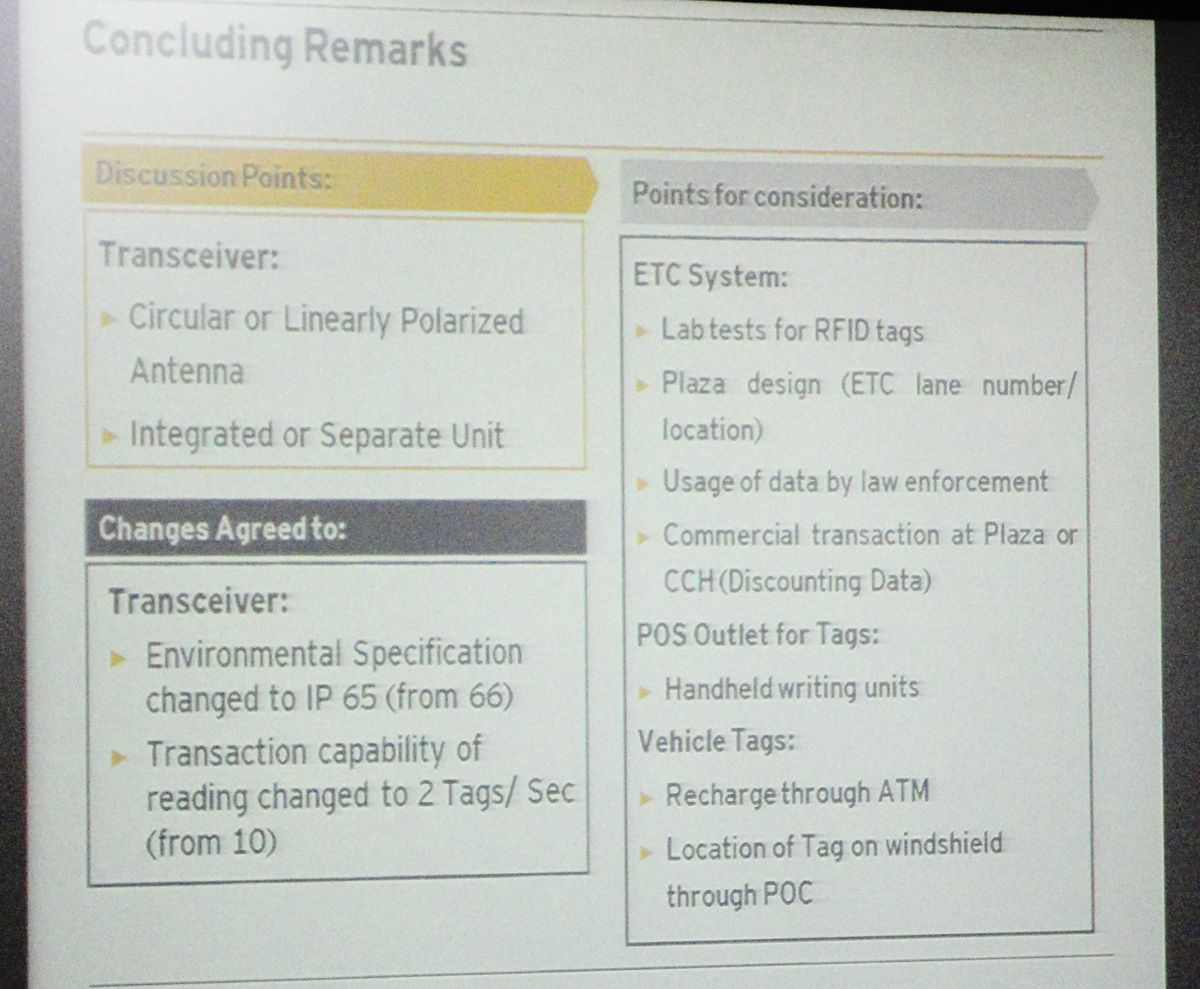Chennai: The IT corridor, dotted with software companies, educational institutions and mushrooming swanky multi storeyed residential apartments, triggering more development by the day, has brought a new problem.Increasing traffic congestion is becoming a cause for concern to the government.In an effort to reduce the traffic congestion, the state government has proposed several road infrastructure projects worth over Rs 1,000 crore, including a 45 km elevated expressway on the busy IT corridor to the popular tourist destination of Mahabalipuram. “The project will be taken up in two phases and the work will be completed from Taramani up to Siruseri in the first phase and from Siruseri to Mamallapuram in the second phase,” chief minister J. Jayalalithaa said. Making a suo moto statement in the Assembly on Monday, she said Rs 5 crore would be allocated to prepare a detailed plan to implement the project at the earliest.Ms Jayalalithaa said the 22-km road up to Thiruninravur from Padi was handed over to National Highways Authority of India in 2005 based on the request of NHAI. But the authority did not upgrade the road since there was no provision for toll collection and as a result the road lacked maintenance, she said.
‘Intelligent Safe Travel’ system mooted to track traffic violations on Mumbai-Pune Expressway
May 29, 2013

The proposed system, worked out by city-based Science and Technology Park (STP), an autonomous institution under central government, could be installed at a control room on mid-way Lonavala, if given the final nod by the state Public Works Department, an MSRDC official said.
Rajendra Jagdale of STP confirmed that the MSRDC had approached the STP for devising an effective traffic surveillance system for the e-way, witnessing an increasing number of accidents due to over-speeding and lane cutting.
He said the system called “ Intelligent Safe Travel” (I-safe-t) will detect traffic offences and relay the data identifying the vehicles to the control room to track the erring drivers.
The data relayed to the control room to be manned by highway police, MSRDC and RTO personnel will include digital pictures of the vehicle, its registration number, location and time of spotting.
Cameras installed on gantries — a bridge like overhead supportive structure — at seven points along the e-way will graphically capture the images of the erring vehicle drivers, who would be penalised by highway police at the toll plazas on either ends of the expressway.
A distinct feature of the system will be the digital display boards giving information and alerts on the traffic conditions and road blocks along the way, as well as featuring and notifying the vehicles involved in traffic violation.
“The system is devised to create a fingerprint of the erring vehicles using their external features to track them down without depending only on number-plates for identification,” said Jagdale.
In addition to the vehicle monitoring to curb the traffic violations, the “ i-safe-t” has also envisaged deployment of security personnel trained to undertake immediate safety measures to rescue accident victims, who can reach the site within five minutes and save precious lives.
“We are processing the STP proposal on ‘i-safe-t’ surveillance system which has been accepted in principle by the MSRDC,” the MSRDC official said.
The e-way, which has cut the travel time between the two mega cities considerably making it approximately a three hour drive, has also been drawing flak for its heavy number of mishaps averaging one every day.
Six Laning of expressway to be over in two years
May 17, 2013
Written by Parvati Sharma

The journey between Ahmedabad and Vadodara is all set to become more comfortable as the project of six laning of the highway joining the two cities is expected to be over in the next two years. The work on the Rs 3,300 crore project has already
started and the financial closure is expected to be over soon. Sources said that the National Highways Authority of India (NHAI) is expediting the project as once completed, this will result in the entire Ahmedabad-Mumbai stretch being six-lane. “In fact, the four-lane expressway and the six-lane highway will be a bonanza for the travelers between the two cities. The people will have ten lanes connection at their disposal,” said an official. The project is to be executed under design, build, finance, operate and transfer (DBFOT) basis in BOT (Toll) mode of delivery. “The road is expected to give an annual income of Rs 300 crores just from the toll,” said a source.
Another ambitious NHAI project nearing completion is the road connecting Ahmedabad with Indore in Madhya Pradesh. The work on Gujarat end is almost over and that on the other side is also being executed swiftly. “Once over, the journey from Ahmedabad to Indore will not take more than seven hours,” the source said. The source further said that the four laning of the road between Jetpur in Rajkot and Somnath in Junagadh is also nearing completion. This would mean that the entire stretch between Ahmedabad and Somnath would be four-lane. “There is a small issue pertaining to land acquisition on Junagadh by-pass which will be resolved soon,” the source added.
45-km elevated road on IT corridor to Mahabs
April 9, 2013
45-km elevated road on IT corridor to Mahabs
Expressway project costs shoot up to Rs 45-50 cr a km
October 10, 2011
The Union road transport ministry is finding it difficult to adopt a viable economic model for access-controlled expressways. The current cost estimates have shot up to Rs 45-50 crore per km against Rs 10 crore a km needed for six lane highways.
With such a huge investment requirement, the ministry is unsure if the build operate transfer (BOT) model for public private partnership projects (PPP) is viable. If the BOT model is adopted, the toll fees will have to be kept very high to recover the cost over a 30 year period. “State and national highways with lower toll would entice more people to use them,” a senior government official said.
The ministry has drafted a plan to construct 15,600 km of expressways by 2022 and has identified over 40 stretches for the same. The idea is to create an Indian National Expressway Network by the 13th Five Year Plan. The plan is to cover special economic zones (SEZs), industrial corridors, industrial towns and densely populated cities to raise the average distance travelled by a vehicle from 300 km per day to almost 600-800 km a day.
The BOT annuity model, where the government pays annually or bi-annually to compensate the private developers, also appears to be unviable, say officials. The reason is that such high cost of construction will entail huge public expenditure while there are other competing sectors in the economy which are vying for same allocations.
“The third model before us is the engineering procurement construction (EPC). Which is not an option here as that would again imply a huge burden on the government’s exchequer,” the official pointed out.
In developed countries, the first 50-100 km of expressways are built by the government to attract private developer. Once traffic picks up on the route, the developers build the remaining length of the expressway and is allowed to charge toll on the entire length (including the stretch constructed by the government).
The government allows this as an added incentive towards recovering the cost of construction and reaching the targeted internal rate of return.
Source: indianexpress.com
Workshop on Nationwide Electronic Toll Collection, held at Vigyan Bhawan, New Delhi on June 14, 2011
June 15, 2011
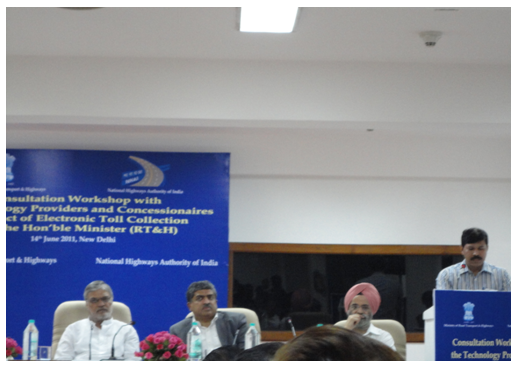
Workshop on Nationwide Electronic Toll Collection
- Mr. C P Joshi , Honrable Minister Road Transport and Highways
- Mr. Nandan Nilkani , Chairman , UIDAI
- Mr. R S GUJRAL , Chairman NHAI
- Mr. Ravi Palekar , GM (Electronics) , NHAI – Addressing the gathering
- Mr. Sachin Bhatia, CEO, Metro Infrasys
Workshop on Nationwide Electronic Toll Collection held at Vigyan Bhawan, New Delhi. With an objective of paving way for a unified Electronic Toll Collection (ETC) technology for National Highways in India, the Ministry of Road Transport & Highways constituted a Committee under the chairmanship of Shri Nandan Nilekani Chairman of UIDAI with a mandate to examine all technologies available for Electronic Toll Collection (ETC) and recommend the most suitable one for implementation throughout India. The other members of the Committee are Prof. Pankaj Jalote, Director, IIIT-Delhi ; Dr. Kolin Paul, Asst. Professor, IIT-Delhi ; Shri A.V. Sinha, DG (Road Development) & Special Secretary, MoRT&H and Shri. V.L. Patankar, Member (Technical), NHAI (Member Secretary).
The Union Minister for Road Transport & Highways Dr. C.P. Joshi has said that we should chalk out a plan to increase the percentage of national highways from present 2.2 % to 5 % in the next 10 years. Delivering inaugural address at the Consultation Workshop with the Technology Providers and Concessionaires in respect of Electronic Toll Collection (ETC) here today, he said that keeping in view the various types of highways there should be a hybrid pattern of toll collection. The Workshop was jointly organized by Ministry of Road Transport & Highways, National Highways Authority of India & National Informatics Centre. The Chairman of UIDAI Shri Nandan Nilkeni & Minister of State for RT&H Shri Tusharbhai A. Chaudhary also addressed the workshop. Shri R.S. Gujral, Secretary Ministry of Road Transport & Highways and Dr. V.K. Gairola, D.G (NIC) were present.
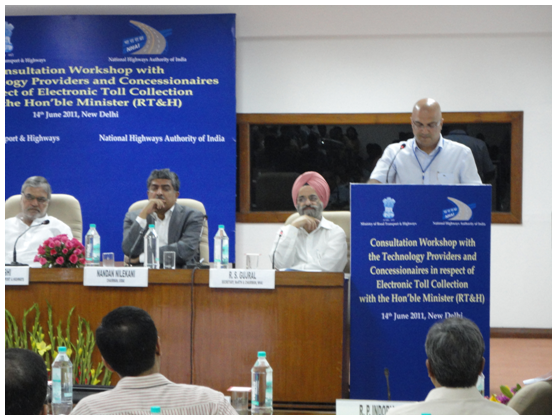
Mr. Sachin Bhatia CEO Metro Infrasys expressing the support from Industry Fraternity
Based on the recommendations of the committee headed by Mr. Nandan Nilekani to use RFID technology for ETC, the Apex Committee, responsible for ETC implementation planning, is in the process of prescribing certain standards which should be complied with all over the country to ensure interoperability. The primary purpose of this workshop was to take feedback from the key stakeholders, comprising concessionaires and ETC technology service providers. Security, cost effectiveness, convenience and scalability have been the main criteria based on which the detailing has been done.
Based on the feedback, the specifications and data detailing will be finalized for open market release. The plan is that the authorized manufacturers will be producing Transceivers and Tags based on these standards, the concessionaires will be procuring these Transceivers and in turn, the technology service providers will be integrating the entire ETC system at the toll plaza. Although details on other aspects like clearing house are being worked out simultaneously, majority of the decisions will depend upon these standards only.
Followings are the Tolling Companies, RFID Manufacturer and concessionaire took part in the workshop:
- Kapsch Metro
- Egis Infra
- L&T Infra
- GMR
- HCC Infrastructure
- JICA
- IRDSA
- DSC
- EFKON India
- Siemens
- IAITO Infotech Pvt. Ltd.
- ESSEN, Mumbai
- ATT System, Banglore
- Mitsubishi
- IBI Group
- Neology
- Steria
- Tag Factory
Brief of discussion over finalization of technology between committee and Industry Peoples:
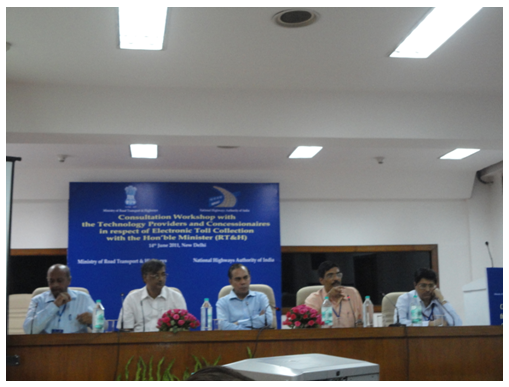
- Dr. B.K. Gairola, Director General, NIC – extreme left
- Dr. Y.K. Sharma, DDG, NIC - middle position
- Dr. Rajat Moona, Director General of CDAC, IIT Kanpur
- Dr. Y.K. Sharma, DDG, NIC - extreme Right
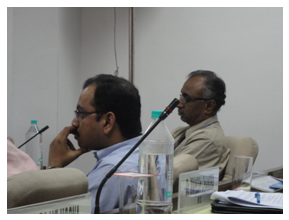 Mr. Venkat from GMR expressed change from IP 66 to IP 65 for the readers as IP 65 is also good enough and IP 66 will increase the cost for the readers without any additional value.
Mr. Venkat from GMR expressed change from IP 66 to IP 65 for the readers as IP 65 is also good enough and IP 66 will increase the cost for the readers without any additional value.
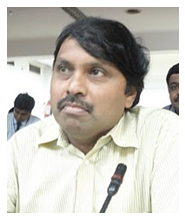 Mr. Hari from Efkon
Mr. Hari from Efkon
He raised an issue over the relative humidity of 100% for Transceiver antenna.
Committee Conclusion :
Committee agreed for the IP 65 standard and 95% relative humidity as it comply against all possible environmental threat at toll scenario.
 Mr. Anand Shenoy from IAITO Infotech Pvt. Ltd.
Mr. Anand Shenoy from IAITO Infotech Pvt. Ltd.
Raised his voice over minimum requirement of reading of 10 Tags per second with 240 bits of EPC memory and 64 bits of Tag Id.
Committee Conclusion: committee agreed onto change it to 2 Tags per second with above said minimum requirement. On the other query raised by Mr. Shenoy that the data retention period must be 3-4 year for the tag memory instead of 10 years as their is no UV protection asked for the tag and without any special material with the effect of UV rays its hard to maintain the data in tag for 10 years, The committee replied as they will keep it under consideration and if required they will bring it in next phase.
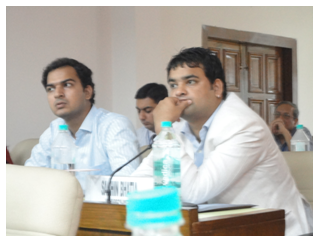 On the query raised by Team from Metro Infrasys- Mr. Nitin Thakur and Mr. Harimohan for the option of having color coded Tags for different class of vehicles, as it will help in operation at toll plazas. The Committee said that it is difficult to see the color in the moving car in the sun. However committee will discuss it in next phase.
On the query raised by Team from Metro Infrasys- Mr. Nitin Thakur and Mr. Harimohan for the option of having color coded Tags for different class of vehicles, as it will help in operation at toll plazas. The Committee said that it is difficult to see the color in the moving car in the sun. However committee will discuss it in next phase.
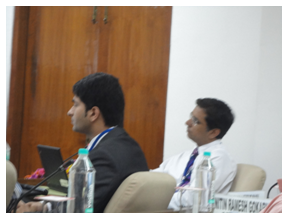 Mr. Vipul Sharma(Left), Mr. Mayank Manish(Right)
Mr. Vipul Sharma(Left), Mr. Mayank Manish(Right)
The long discussed topic was the polarization standard for the antenna, Panel has asked for circular polarization pattern for the antenna but Mr. Vipul Sharma and Mayank Manish from one of the leading manufacturer of RFID Equipment Neology reasoned to have it linearly polarized due to its long range and less interference phenomenon, also linearly polarized antennas can work at higher speed , committee keep this for discussion and will revert again.
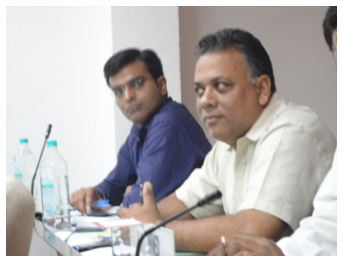 Mr. Manoj Agarwal and Mr. Manish from Delhi Gurgaon Expressway strongly supported the idea of a law for putting a penalty on cash vehicles coming to Tag lane .
Mr. Manoj Agarwal and Mr. Manish from Delhi Gurgaon Expressway strongly supported the idea of a law for putting a penalty on cash vehicles coming to Tag lane .
For the standard for the communication between plaza server and CCH server, there will be addition of Plaza id into the prescribed format by the committee. Plaza level fare plan and policy will be governed by the plaza itself while the global discount will be governed by the CCH server and will be updated in all the plaza server by CCH server itself. Committee also agreed to look into the various aspects of fare plans at different plazas.
Highlights of the Workshop:
ETC critical components:
Tag Distribution Channel & Inventory Management
- On-line channels by user
- Authorized service centers of vehicles (Service centre need to install the SPV client software and antenna connection), since centre must have authorized people to affix tags.
- RTO(Operation is similar to above)
- Vehicle dealer network(Operation is similar to above)
- Authorized point of sale installation(POS can be insurance companies, PUC centers, Petrol Pumps etc; Operation is similar to above)
Inventory Management of Tags:
SPV will keep track of allocated EPC Ids, Tag Ids etc. It will perform a demand forecast Tags and keep the tags available for distribution through distribution channel.
Handling Special Cases
- Valid ETC enabled vehicle was ejected due to non-read of Tag – Premium cash lane should verify it with the ETC database.
- Clone Tag – If customer complains/suspects that his/her Tag is cloned, Tag re-initiation is to be done for same Tag. Old Tag value is marked for special handling.
- Change in registration number of vehicle – Vehicle should approach distribution channel network and get a new tag. Old tag is to be destroyed physically and listed for special handling.
- De-registration of vehicle (due to destruction/ end of life/ Export etc.)-Tag is to be destroyed physically and listed for special handling.
Listing for Special Attention
Vehicle is listed for special attention following conditions:
- Insufficient balance as determined by clearing house
- Credit card co. declined the payment
- On Police look-out
- Suspected cloned Tag
- Tag with invalid Vehicle Registration no. (e.g. when Registration no. is changed)
- When toll plaza operator notices Tag carrying details different from vehicle itself (e.g. the vehicle Registration no. and/ or Vehicle class)
Videos
Conclusions drawn at the end of the seminar:
Documents Attached:
- Agenda Workshop
- Apex Committee for ETC Implementations – GOI, Draft Specifications Document
- ETC Report on RFID – July 2010
 This story is covered by Mr. Sachin Bhatia.
This story is covered by Mr. Sachin Bhatia.
Delhi-Gurgaon Expressway: Job Unfinished
November 16, 2010
 These days driving on the Delhi Gurgaon Expressway in Peak Hours, perhaps you are asking yourself, what must be the traffic condition at toll plaza and at entry road to my office? How much time is needed? Will the traffic move fast or slow? It’s been more than 2 years since the highway became operational but the degree of difficulty in driving on this has increased sharply in recent months as more and more sections are
These days driving on the Delhi Gurgaon Expressway in Peak Hours, perhaps you are asking yourself, what must be the traffic condition at toll plaza and at entry road to my office? How much time is needed? Will the traffic move fast or slow? It’s been more than 2 years since the highway became operational but the degree of difficulty in driving on this has increased sharply in recent months as more and more sections are
becoming congested.
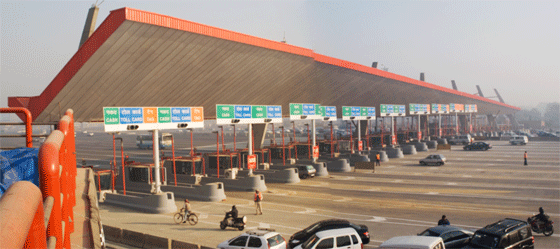
When Delhi Gurgaon Expressway was conceived by NHAI, the main objective was to provide high-speed connectivity between Delhi and the commercial hub, Gurgaon. However, today instead of providing speed connectivity it has become a subject of argument between, NHAI, Concessionaire and planning authorities of Haryana and New Delhi.
January 2008 marked the completion of the much-awaited Delhi Gurgaon Expressway but due to lack of proper planning, poor traffic forecasting, unplanned traffic management, poor urban design and lack of traffic enforcement it became a nightmare for the users. Further the increased traffic added to the mess in management of the highway and concessioner faced a huge challenge in starting the operations.
It is very sad to see this highway in such a sorry state of affairs where the issues are not addressed by the stakeholders but just being passed on to each other. Today, contrary to high expectations, this highway is just another ordinary road and is not able to give a nice driving experience to the road users and leave a good impression on the users.
The aesthetic perception for highway user is very bad indeed which conjures up images of choked Hero Honda road with overflowing drain water, poor service roads, narrow entries and exists, poor landscaping and toll plaza lanes welcoming commuters with choked lanes and driver criss crossing the lanes. This highway in the National Capital Region of India is far from creating an impression on any visitor from abroad who touches it when he enters the city and suburbs. It is a far away from the natural landscape and aesthetic quality which we can see internationally in all highways. Concessionaire was given the design with which he has to construct and operate now.
Expert highway planners and traffic engineers were not able to envisage for amenities required for the highway. The high cost of right-of-way acquisition generally prohibited the creation of buffer zones between highway and neighbourhood. Bridges, overpasses, skyways, fencing, sound barriers and interchanges that are a basic necessity on this stretch were not envisaged and now after development these are being accommodated in an unplanned manner. These unplanned and graceless structures are not well designed and lacks the aesthetic appearance.
The biggest challenge on this highway in the coming years would be circulation of traffic. Traffic planning and enforcement has not been addressed adequately leaving concessionaire of the highway helpless. For more than 50 villages on both sides of the road, this is another massive freeway which is used without payment of any toll, without any policy and without any documented right since they were overlooked at the planning stage. Today the challenge for the office going people is not just to drive on this but taking the entries and exits on this as well. All entries and exists are narrow and curvy lacking center lines and ample shoulders. At peak hours it takes more than 40 minutes which is almost double the time for crossing the highway. Prime commercial areas and prime residential localities of Gurgaon close to these exits and entries are facing the
heat of this oversight.
Since it began operation, safety has been a big issue and it has also achieved the notoriety of being called “The Killer Highway”. There are only limited over-bridges along the entire stretch to cater to the communities living on either side of the heavily populated areas through which the expressway runs. Right from fencing to over-bridges, everything is being implemented on a need basis now. Few issues are still un-addressed like movement of two-wheelers which is almost equal to the existing traffic on the expressway and effort has not been made even to count them so that some planning can be done for accommodating them on this highway. Half completed service roads and poor signages have also added risk to the users on the highway.
This development is not without its drawbacks – traffic congestion is a serious issue, especially at the toll plaza. During peak hours, it can easily take up to 15 minutes to cross the toll plaza which would have taken a minute to cross if managed properly. The highway operations staff needs lot of training in highway management and operations. The benefits that construction of this expressway offered in terms of employment and connectivity is outweighed by traffic congestion. The toll plaza at the Delhi-Gurgaon border has also proved inadequate in handling the increasing traffic, leading to traffic jams during peak hours. Though the plaza is tag enabled, only 35-40 percent of the traffic that passes through avails of this facility and that too with lot of mess.
From dense fog in winters to scorching heat waves in summers, from over loaded truck on the main highway to two wheelers zipping from all directions, from the encroached service roads in Haryana to un- authorized parking on service roads, from high speed to bad traffic etiquettes on Expressway, from Cash Users in Tag Lanes to Blacklisted Tag users, from lack of Basic Amenities to power failures in highway lighting, from lack
of VMS signages to stray animals on Highway, there are lot of issues that need to be addressed in Highway Management.
Highways are not only meant for driving. Internationally highways are meant to give a pleasant experience to the users where they feel safe to drive and reach their family and home in time. Aesthetics of expressway in terms of median, edges, lighting and road furniture is developed in such a fashion that it adds to the driving experience. The idea is to choose pleasing aesthetic solution which appeals to the users without compromising the safety issues of the highways.
To conclude, the Delhi Gurgaon Expressway has not only made developed localities of Gurgaon more accessible, it has also facilitated development of new localities. Master Plan 2021 has opened many sectors for development which benefitted with better connectivity after completion of this expressway. However, the quality of services on the Delhi-Gurgaon expressway might get worse if not addressed on time. Gurgaon is already booming and it needs improved connectivity and a sharp reduction in travel time, both within the city as well as to and from the national capital. All stake holders and people involved in this project need to sit together and seriously deliberate to address all outstanding issues. A time bound plan for addressing these issues can be done only by a truly innovative way of thinking about the freeway in the urban environment.
All said and done, much work still remains to be done……
Sachin Sharma
Executive President -Infrastructure
Bajaj Hindusthan Ltd
www.bajajhindusthan.com
Now that the Toll Industry has had a few years of maturity. What is the summary of expections from Toll Collection System from a concessionaire’s point of view.
May 10, 2010
(This needs an in-depth analysis on broad parameters. However I have tried to analyze few problems associated with toll roads.)
M S V Ramu
Profession – Contract Manager
Date: May 4, 2010
E-mail: [email protected]
Introduction: with a need a build good infrastructure and lack funds available to finance these Highway project government has undertaken to built highway on Public Private Partnership either toll based or annuity based.
The private developers who bids and undertake constructions of Highway on toll basis needs to implement a through pertinent “risk” management system with the help of the government to mitigate all the risks that come with development.
To understand the various consequence of “tolled” roads there needs to through study to undertaken which is not my purview at the moment. Hence I dwell over some of these consequences based my exposer these projects.
Toll based Highways:
The idea of “Toll based” highways was imported into India from experiences of others countries like Europe, Malaysia or North America. The model “Concession Agreement” was drafted by the Government to suit India needs.
The toll categories of roads are those wherein there are sufficient traffic which can be tolled by the Concessionaire and recoup the investment made him and also make profit. In the event there are not enough tollable traffic to recoup the investment made, it will be offered on annuity basis or with VGP (Viability gap funding) by the government.
The tolled based roads wherein the Government grants private developer specific rights to design, finance, construct operate and maintain the roads. The developer called “Concessionaire” develops covers the investment costs and carry commercial risks since he relays on operation revenue from the tolls remunerated. At the end of the concessional period the road reverted back to government at no extra charges. However if the estimated revenue does not materialize during Concession period the Concessionaire may have to negotiate the concession period (as in other countries) which is yet to happen in India as we are just starting!
In south America there is method of bidding known as “Least Present Value” wherein the winning bidder is the one who asks for “smallest Net Present Value” and period of the concession period ends when the present value of revenue equal to winning bid. This model has not been tried in India.
Risk management in “Toll based” Concession
In the present circumstances the Concessionaire undertakes risks to constructs road which is generally divides normally into three parts:
- Certainty – decision maker know exactly the outcome
- Uncertainty – here the decision maker does not know the risks due to non availability of any data
- Risks – are those which can be determined by statistical terms and can be analyzed but it differs from uncertainty
In risk management all the risks are quantified and analyzed and decision taken by the Concessionaire to mitigate the same by way of disciplined approach to critical situation
Developmental risk involves “Land Acquisitions” needed for the project. This is one of the biggest risk faced by the Indian developers as most of the times project gets delayed due non-availability of Land. NHAI does not meet the contractual requirements specified in the Concession agreement thereby causing unnecessary hardship to concessionaire. This risk falls under “uncertainty” which can not be quantified
Financial Risk: Soon after award of Project, the Concessionaire needs to raise the necessary capital required for execution project
There are two major risks involved:
- Ability to raise the finance and make financial close as required by the Concession agreement.
- High interest rate during the currency of concession period (due to floating interest charged by lenders) – mitigation of this risk in extremely important).
Construction risks
Whether the construction undertaken by the Concessionaire himself or by other contractor there are many risk involved
- Poor performance of the contractor
- Different site condition which normally experience contractor many not have thought off which is problematic and end up in high cost due additional items of work to be executed.
- High price escalation of all the inputs of construction – Example: steel pricing going through roof last year.
All above risk has to be born by the Concessionaire which needs proper approach in the initial stages itself
Operational risks
Operation risk involves mainly the following
State support agreement – needs to signed by the concerned state and they shall support the collection of tolls which important to the concessionaire. NHAI who are promoters of the project should take full responsibility in getting the agreement signed with Concessionaire as Concessionaire can not exert any pressure on the states
Toll Level: the estimated toll level uncertainty during pre-bidding stages can lead to inaccuracies in revenue estimation which the Concessionaire has based his bid. Hence this risk needs to shared by the NHAI
The traffic volume projected in financial model may not materialize as it completely depends on economic growth projected during pre-bidding stage
Any fall in traffic volume will automatically bring down the IRR value projected. Expert estimate that 10% drop in volume of traffic will result in reduction of 1-7% – 1.9% percent reduction in IRR.
Toll collection
The Concession agreement does give any standard specification for the installation of tolling equipment. This has resulted in haphazard manner the tolling equipment being installed by the different Concessionaire. This needs to change. For example a RFID card issued at New Delhi should also hold good down south. By such an arrangement the road user can travel effortlessly any ware in India.
The technology used by the Concessionaire needs to be streamlined on all India basis for all Concessionaire.
Toll fee: The price escalation of “toll/Fee” charged by the Concessionaire is based on all India WPI index. This is incorrect as in some states it may be very high. In my opinion there should be “Toll Regulator” on all India basis to regulate toll based on each state WPI or any other base model
HTMS: Here there is no comprehensive approach. For example the “variable message system” is limited to one project length only! This also needs an all India approach.
Suggestion: at the moment there are so many “Toll” based road are in operation and also on the horizon. All the toll based roads owners are “Special purposed vehicle” promoted by the concessionaire.
So why not a “over the counter” stock listing be arranged of these SPV and listed in Stock exchanges which can also traded in F&O section. I am sure this arrangement will automatically will mitigate many risks and also give scope for improvement in roads as the Concessionaire would like increase the traffic by enhancing the many amenities for road users.
Thanks for taking time for reading this articles.
Indian government has finally realized the importance of road sector
April 26, 2010
Huge opportunities are unfolding in the Indian road sector. This means most Indian infrastructure and construction companies will benefit from the announcement of new orders or projects in the long run.
Also, a large number of these projects are on Build Operate and Transfer (BOT) and annuity basis, which means the companies will have a steady flow of cash through annuity or toll. This development spells good news for investors who can make full use of this golden chance and earn high returns in the long run.
WHY NOW?
The question that may cross your mind is why now? Ever since Kamal Nath took over as the Union minister for roads and transport, the Indian road segment has taken a new turn. He created various milestones since he was given this portfolio.
The most important announcement he made was the construction of the national highway at the rate of 20 km per day to expedite the achievement of National Highway Development Programme (NHDP) targets. This is significantly higher than the current execution rate of about 6 km per day. The ministry has also been working towards faster clearances related to procedures, land acquisitions and other formalities.
CREATION OF FUNDING
Kamal Nath is aware of the fact that improved road network in the country would not just lead to better connectivity but would also lead to increased energy efficiency in transport operations. He also travelled across different countries on road shows to international investors to highlight opportunities and potential in the Indian road sector.
Through these measures, the government has and will be able to rope in huge investments needed for the sector from international and national long-term investors.
Earlier it was difficult to raise money for more than five years or so as money was available only for a short period. However, now that the corporate debt market is developing, long-term investors like pension funds, mutual fund houses, insurance companies and even banks are coming forward to provide long-term capital. Most road projects, particularly the BOT ones need huge long-term investments in the form of debt and equity to fund them.
INCREASING VIABILITY
In terms of the less viable projects, the government increased the viability gap funding (VGF) or grant to 40% from 25%. Formerly, the grant used to be given after the completion of the project. But now it is handed over at the beginning of the project. In this manner the construction of the project does not get delayed for want of funds.
The government is also working on creating innovative ways of structuring non-viable projects like allotment of land, which can be monetized by developers so that the returns on investments are reasonable.
Other aspects like increasing the role of private players through public private partnership (PPP) and awarding of projects on BOT basis would mean that private players now have a bigger role to play in the construction of viable road projects.
A LONG WAY TO GO
India currently has about 33 lakh km of road network spread across the country. This is the third largest network in the world. But, in terms of density and quality of roads, India still lags behind many developed and developing countries of the world.
In relation to our population, the country’s roads are about 3 km per 1,000 persons, which is significantly lower than the world average of about 7 km per person. In terms of quality, about 80% of our roads are in a poor condition and require huge investments for repair, renovation and increase in the number of lines.
Majority of India’s roads are single line in spite of increasing traffic and congestion. Even the conditions of our existing roads are so bad that India’s logistical cost as a percentage of total production cost is considered to be about twice the world average of 7%.
No wonder due to the poor road infrastructure, India is ranked 87th in the world on the basis of quality of roads, which is very low and considered to be the biggest hindrance for economic growth as envisaged by the government for the coming years.
Surprisingly, within this vast network of roads, only about 2% is accounted for by national highways and a very minuscule part is accounted for by express highways, which is very critical considering that about 40% of the total road traffic is handled by national highways.
The slow transportation of goods has also affected the movement of goods among states, delaying exports and imports of the country. Especially, in the case of transportation of perishable goods like milk, vegetables and flowers among other things, which are procured from the hinterland takes so much time that they become stale or get destroyed before they can actually reach the end consumer and the export market.
This leads to wastage of goods due to the delay in reaching the markets. Express road connectivity to the main ports of the country and to major cities is very important to improve trade volumes and discover better prices for farm goods.
WHAT IS CHANGING?
The government has realized the importance of better roads in the country so that it can support the growth of the economy in the coming years. Roads are critical for any economy, especially a growing economy like India with a large population and different topographies.
The role of roads is of paramount importance for commercial and economic activities in the country. In India, passenger traffic is growing at about 12% per annum, while cargo traffic is growing over 15%, which will continue to rise as economic activities improve along with the increase in foreign trade.
India’s foreign trade is growing at 10-12 % and there is an immediate need to connect all the major ports of the country. The government has taken the first step in this direction. Under the NHDP (phase II), the government will connect major ports and build freight corridors, which will connect many states from the eastern part of India to western India.
In phase III of the NHDP, all major capitals will be connected with highways. Also major cities and points that could not be connected in phase II will be connected with better road infrastructure. Besides, plans are afoot to improve and connect rural India to major cities of the country soon.
EASING HURDLES
Most of these plans are not just on paper. In fact the government has already awarded projects to achieve this goal. The government formed the BK Chaturvedi Committee, which presented its findings and suggestions to make progress in the sector.
Based on the findings of the committee report, several changes have been incorporated and more importantly, the government is seriously working on the recommendations, which are quite innovative and provide solutions to various problems that the companies have been facing.
Changes have been incorporated with regard to land acquisition, which is the biggest problem for construction of roads in the country.
Now, NHAI will work along with the state governments for facilitating land acquisition and all state governments have been directed to coordinate for the same. NHAI now awards road projects only after 80% of the land has been acquired.
FEW SPEED BREAKERS
Tackling delays in approvals, decision-making, faster resolution of disputes and coordination among different departments are few other highlights of the recommendations of the committee report.
Essentially, most of the changes are already in effect and new orders are awarded to interested parties. The flow of new road orders in the last few months was the highest in the last several years. This itself speaks volumes about the commitment of the government and its intention to put things on ground.
Also, the projects which were not viable and did not attract private participation were given extra focus and restructured within time frame along with consultations of private players while changing the terms and conditions of the project. There are other measures also which have attracted private participation in road projects.
Large projects will be built on a BOT basis, which are expected to have a higher return of about 18% to 20% on investments as compared to 14% to 16% earlier. Additionally, the new guidelines that have been framed are such that once a project is awarded for a particular road, the private player is given an assurance that there will not be any competition or construction of road, which will make sure that the cash flow in terms of the collection of the toll is protected.
What is more remarkable is that the government now has experts as representatives from development agencies like the World Bank, the Asian Development Bank, who make sure that the projects are not delayed and hurdles are resolved.
These representatives keep track of projects and act as a liaison between government agencies and private parties. They also bring their experience to structure the project in such a manner that it gets executed.
QUANTUM OF OPPORTUNITY
There are different estimates about the size of the opportunity. But there is little or no doubt that the opportunity is far bigger than what it used to be a few years ago.
When we talk about 20 km per day of the construction of roads, this in itself is self-explanatory. This means that the country will have to build about 7,300 km of roads every year. This is significant as the current run rate is just about 2,500-3,000 km of roads built every year.
One could also imagine the kind of work that will now flow. For the eleventh five year plan which will end in 2012-13, about Rs 3.14 trillion will be invested as compared to Rs 1.45 trillion invested in the tenth five year plan. This is still the tip of the iceberg. India’s investment in the roads segment is expected to be in the range of Rs 10.5-11 trillion over the next decade.
In the near term, about 5,000 km of new expressways will be built and the projects will be awarded for the same. Also, NHAI has plans to award work for about 37,000 km of roads over the next three years.
Besides, under the NHDP’s different phases, the government will award work relating to the upgradation of about 55,000 km of roads over the next 8-10 years.
WHO WILL BENEFIT?
Most construction and infrastructure companies are focusing on this particular segment and their exposure has gone up in the recent past. IRB Infrastructure and IL&FS Transport Network (ITNL) are popular in the roads segment having the highest exposure to the road segment. In the case of IL&FS, the company has recently come out with an IPO and was listed recently.
ITNL is amongst the largest private sector BOT road operators in the country having integrated business model providing service for projects, from conceptualization, construction to operating and maintenance of the road projects. The company has already bagged about 19 road projects.
Apart from roads, the company is also looking for opportunities in airport segments and plans to bid for more projects in this segment. The company’s advantage is its large portfolio of BOT assets and a long experience in the sector. The company has presence across different parts of the country and has about 9,397 lane km of road projects under its belt.
IRB Infra too is a leading player in the roads segment generating almost 100% of its revenue from this segment. The well-known Mumbai-Pune highway, one of its kind in India, is operated by IRB Infra.
The company has an integrated business model having large experience in toll roads and highways sector. The company has about 1,100 km of road projects in its kitty, which is the second largest among private players in the whole of India.
As opportunities are growing, the company should be able to procure more projects and increase its current portfolio. The company will not only benefit on account of the construction of these projects but also due to the collection of toll and annuity from these projects, providing stable future cash flow.
Also most of its projects are strategically located in major traffic areas like Mumbai-Pune, Mumbai-Surat, etc. The company also won projects in other states like Rajasthan and Punjab and is gradually focusing on becoming a pan-India player in the road segment.
Source: stockmarketsreview.com
TEXT-Fitch affirms SNBTPL ‘s bank loans at BBB-(ind)
April 19, 2010
April 16 – Fitch Ratings has today affirmed SEW-Navayuga Barwani Tollways Pvt Ltd.’s (SNBTPL) senior long-term project bank loans aggregating INR5,474m at ‘BBB-(ind)’, and subordinated bank loans of INR300m at ‘BB+(ind)’. The Outlook is Stable.
SNBTPL enjoys an 18-year concession from National Highways Authority of India [NHAI.UL] (NHAI, ‘AAA(ind)’/Stable) to design, engineer, build, finance, construct, operate and maintain on a Build, Operate and Transfer (BOT) basis an 82.8km road stretch on the National Highway 3 (NH-3) in the state of Madhya Pradesh. The estimated cost of the project is INR7.9bn, with the scheduled commercial operations date (COD) in May 2011.
The affirmations follow SNBTPL’s reasonable progress over the last year in achieving different project milestones during the critical construction phase. Fitch does note however that the company is slightly behind plans. The entire right of way (ROW) required for the project is reportedly in the company’s possession, with the exception of a three-km stretch of forest land; however, first-stage approvals have been received from the forest department.
As of March 2010, the project has received equity infusions (61.3%), and has been drawing down on term loans – 58% of senior debt and 57% of sub-debt – as per schedule.
The ratings are constrained by the residual completion risk, although a fixed-price construction contract with SEW, whose terms mirror those in the concession, offer protection. Base-case debt service coverage metrics are extremely modest and vulnerable to various deep stress tests Fitch performed. A three-year tail in the concession allows the banks to restructure the loans, if necessary. Some liquidity support is available in the form of a fully-funded debt service reserve account (DSRA), equivalent to three months’ principal and interest payment.
Fitch has factored into its rating the operational track record and financial strengths of the sponsors. This includes the credit enhancement value of their undertaking to finance the cost and time overruns, to replenish the senior and subordinated DSRA and to provide unconditional and irrevocable bank guarantees if event project cash flows are inadequate to create the DSRA. Additionally, SEW has executed a letter of undertaking to the senior to infuse INR100m, after the COD, to augment debt payment capacity and to inject additional funds in case operations and maintenance expenses exceed the base case projections submitted to the banks.
The agency believes that the road has long-term economic potential, and that its locational advantage should have a beneficial impact on tollable traffic. Also, it is situated on the highway that represents the shortest distance between Mumbai and Agra.
SNBTPL is a 74:26 JV between SEW infrastructure Ltd (SEW, ‘AA-(ind)’ / Stable) and Navayuga Engineering Constructions Ltd (NECL). Following inter-se adjustments among the sponsors, SEW has increased its equity stake in the project to 74% from the 51%, resulting in a reduction in NECL’s holding to 26%.
Applicable Criteria available on Fitch’s website at www.fitchratings.com: “Rating Criteria for Infrastructure and Project Finance”, dated September 29, 2009.
Source: in.reuters.com
NHAI brings down rent for wayside amenities
April 3, 2010
The National Highways Authority of India (NHAI) has brought down its annual rent to 1 per cent from 10 per cent for building wayside amenities on highways across the country.
The roads authority is now seeking rent at one per cent of the cost of the land per annum for the first year. Thereafter, an additional one per cent will be added every year with the rent being capped at 10 per cent.
NHAI plans to develop through private participation an amenity at every 50 km on highways. They would include parking lots, snack bars/restaurants, toilets, restrooms for short stay, first-aid centres, telephone booths, petrol pumps/minor repair shops (optional), kiosks for sale of miscellaneous/sundry items, landscaping and space for spreading awareness on government welfare programmes.
NHAI had earlier received three bids for 29 projects it had put up for tendering. The authority then decided to relax the criteria. The lease period for the projects has also been doubled to 30 years to make them more profitable and attract more bids.
Among other changes, NHAI has relaxed the pre-qualification norms. Any private participant with only a year of experience can apply for building the wayside amenities. Earlier, private participants required to have an experience of five years.
The authority had not found takers for 26 wayside amenity projects even after four-five attempts. To make the projects viable, NHAI has now hired consultants to find potential sites along the East-West and North-South corridors. The field officers of NHAI have also been directed to identify at least one site for development of comprehensive wayside amenities.
Source: business-standard.com
